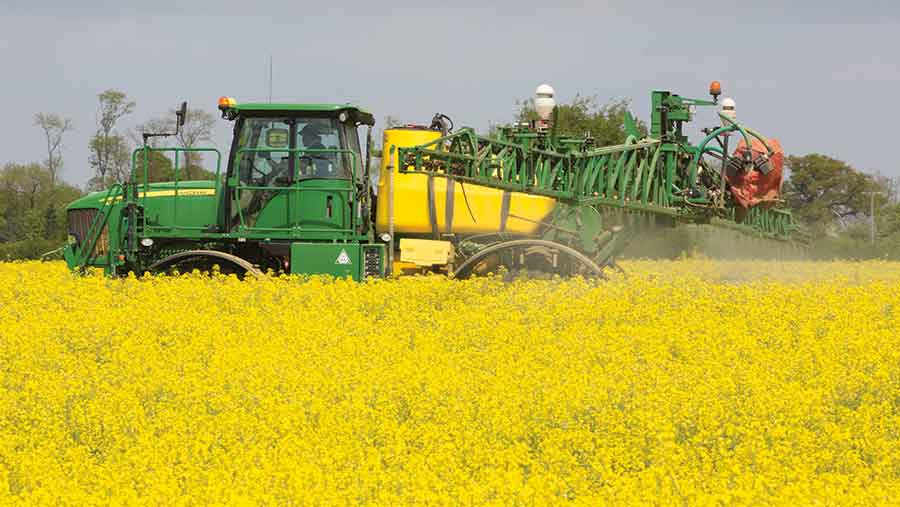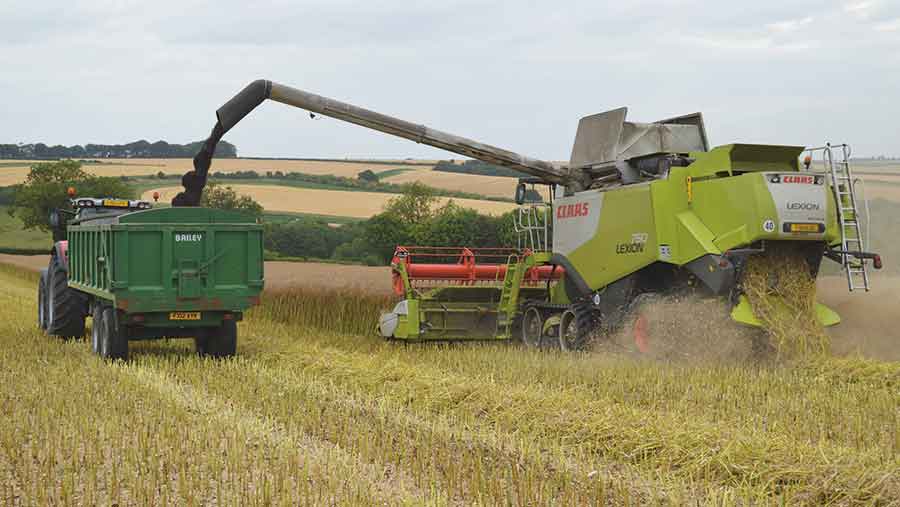Oilseed rape area is set to slip for fifth year in a row
The oilseed rape crop area could drop by as much as 10% this autumn to show the fifth successive annual fall as some growers give up on the crop due to low yields this harvest and ever-rising costs.
The eastern regions of England are likely to see the biggest falls due to fears of cabbage stem flea beetle damage and a move to widen crop rotations, while western and northern areas are set to see less of a fall.

© Tim Scrivener
Those staying with the crop are looking to cut costs by moving towards conventional varieties and also Clearfield herbicide-tolerant varieties, while some have been encouraged by higher rapeseed prices.
Barry Barker, national arable seeds product manager with seed supplier Agrii, says growers are moving to conventionals rather than hybrids, while there could be more farm-saved seed as growers cut costs.
Fall in rapeseed area
“I would be surprised if the area is not down, and at the moment it looks as if the area could be down by 10% overall,” he tells Farmers Weekly.
See also: Harvest 2016: Early Essex oilseed rape crop shows yield of 3.7t/ha
The UK crop just harvested this summer is estimated at 580,000-590,000ha, so if there is a 10% fall it could be the smallest oilseed rape crop for 25 years.
Chris Piggott, seed commercial assistant at fellow supplier Frontier, believes the fall will be largely confined to the eastern areas of England from East Anglia up to the Yorkshire Wolds, and could amount to a 5% fall overall.
“The eastern side will see a drop but parts of the country such as in the West look as if there will be not much difference in area,” he says.
The lack of a neonicotinoid seed treatment has had an effect. This season was the third successive season these insecticide dressings were banned due to their perceived deleterious effect on bees.
Last season, emergence use was granted to the four counties of Cambridgeshire, Suffolk, Hertfordshire and Bedfordshire where flea beetle damage was most severe, but no regional use was allowed this season.
Early drilling
Geoff Hall, commercial lead seeds and traits for Northwest Europe at leading breeder Monsanto, sees a smaller fall to 560,000-570,000ha from his estimate of 580,000ha grown for harvest 2016, and adds that drilling progress picking up in August with many growers flat out drilling in the middle two weeks of the month.
“Some growers were keen on early drilling starting as early as late July to get the crop established before flea beetle attacks,” he says.
Growers have suffered lower yields largely due to a lack of sun in June and crop consultants Adas say typical farm yields are nearly 14% down at 3.0-3.2t/ha compared with a five-year average of 3.6t/ha, while AHDB Recommended List variety trials show yields down about 16%.
Owen Cligg, trading manager at co-operative United Oilseed, says this summer’s crop is likely to total 1.7-1.8m tonnes based on an average yield of about 3t/ha.
This is sharply down on last year’s 2.5m-tonne crop, and the record 2011 crop of 2.8m tonnes, and could be the lowest since 1992’s 1.5m-tonne harvest.
He says some grower may have been encouraged to stay with oilseed rape as prices have crept above £300/t due largely to the weakness of the pound, and rapeseed currently trades about £310/t ex-farm before any oil bonus.
Farm-saved seed
Many seed trade managers point to a small swing towards conventional varieties, as the seed can be farm saved and is cheaper than the more expensive hybrids, which can’t be farm saved.

© David Jones
Agrii’s Mr Barker expects conventional varieties may have edged up their share of the market to 55%, with Elgar and Campus his top sellers, while among the hybrids, Exalte and Alizze are best sellers this season.
He says among the conventional varieties, Elgar, which tops the AHDB Recommended List (East/West) for gross output, has sold out, Anastasia is the most popular in Scotland and the north of England, while Nikita has sold well.
Frontier’s Mr Piggott is seeing a more 50-50 split between conventional and hybrids, with Extrovert being the top hybrid and Picto the leading conventional variety.
“This year we have not seen a huge move to new varieties due to uncertainties with establishment,” he says.
Disease resistance
Beckii Gibbs, seed sales manager at United Oilseeds, says growers are clearly moving towards varieties with better disease resistance and this has seen Barbados being her best selling conventional.
The variety which is on the AHDB Recommended List only for the North has sold well further south reflecting its high disease resistance scores of two 7s for both light leaf spot and phoma. The variety showed a very good yield of 5.31t/ha on a farm in Wiltshire, she says.
Among the hybrids, Incentive and Exalte are her two best sellers, with the club root tolerant variety Mentor still doing well in the North.
“We have certainly seen a lot of growers drilling early to get away from flea beetle,” she says.
Another swing seen by many seed traders has been a move into Clearfield hybrid varieties, which are tolerant to specific imidazolinone herbicides.
These varieties have been conventionally bred with natural resistance to these herbicides and can allow growers to reduce their autumn herbicide bill.
Triple in area
These type of varieties could triple in area to about 40,000ha this autumn as there are now better yielding varieties on offer, while they offer good control of problematic brassica weeds, such as charlock.
Contamination from weeds like charlock may have led to the high erucic acid levels seen in some crops last season, which led to being some loads being rejected or suffering big price deductions.
The leading Clearfield variety this season is likely to be Imperial CL, and as this and other Clearfield varieties need no pre-emergence herbicides. Growers can wait and see what kind of crop comes through the ground before spending money on weed control.
Monsanto’s Mr Hall says this variety is now one of his group’s top-selling varieties alongside Extrovert, Exalte and V316OL, with this breeder’s varieties controlling about one-third of the oilseed rape seed market.
The move to high oleic low linolenic (HOLL) oilseed rape varieties looks to have hit a temporary setback with a shortage of contracts for these food quality oil varieties amid a glut of sunflower oil. The area of these varieties, such as V316OL, could fall to between 10,000-15,000ha from 20,000-25,000ha last season.
UK oilseed rape crop |
|||
| Year | Area (ha) | Yield (t/ha) | Production (m tonnes) |
| 2012 | 756,000 | 3.38 | 2.557 |
| 2013 | 715,000 | 2.98 | 2.128 |
| 2014 | 675.000 | 3.65 | 2.460 |
| 2015 | 652,000 | 3.90 | 2.542 |
| 2016 * | 580,000 | 3.0 | 1.7-1.8 |
| *Estimates | |||
Oilseed rape 2016 harvest
Yields are generally disappointing, ranging between 1.0-5.0t/ha, with very few crops achieving the higher end of this range, says crop consultancy Adas.
The national yield estimate is put at 3.0-3.2t/ha, 14% lower than the five-year average of 3.6t/ha, with most crops now harvested.
Oil contents are variable with some samples in eastern England below the standard 40% level. Average oil contents are 43%, in a range of 39-45%.

